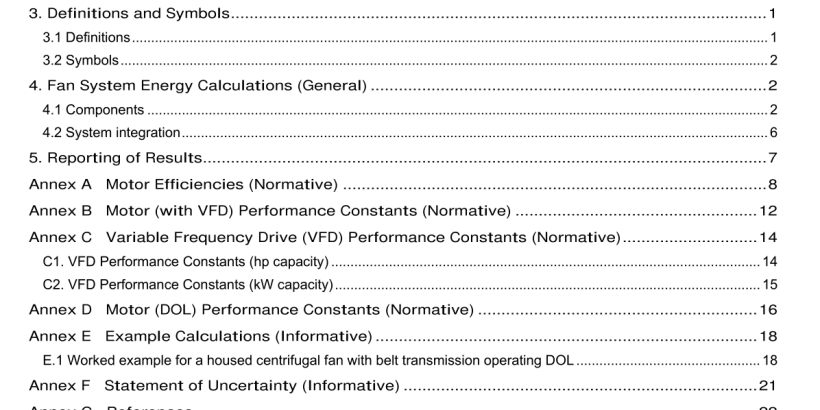ANSI AMCA 207-2017 pdf download.Fan System Effciency and Fan System Input Power Calculation
1 . Purpose
This standard provides a method to estimate the input power and overall efficiency of an extended fan system. An extended fan system is composed of a fan and an electric motor but may also include a transmission and a motor controller. While direct measurement of fan system performance is preferred, the large number of fan system configurations often makes testing impractical. This standard offers a standardized method to estimate fan system performance by modeling commonly used components. Calculations reported in accordance with this standard offers fan users a tool to compare alternative fan system configurations in a consistent and uniform manner. This document does not provide selection guidance. Users must assure that selected components have sufficient capacity and are configured to produce the desired results.
2. Scope
The scope of this standard includes all electric motor driven fan systems that use a specific combination of components as defined below:
1. Fan airflow performance tested in accordance with ANSI/AMCA Standard 210 [1] ANSI/AMCA Standard 230 [2], ANSI/AMCA Standard 260 [3] or ISO Standard 5801 [4] or rated in accordance with AMCA Publication 211 [5].
2. Polyphase induction motors within the scope of EPCA [6], IEC 60034-30-1 [7], or GB 18613 [8]. Other types of motors are explicitly excluded.
3. Pulse-width modulated variable frequency drives (VFDs).
4. Mechanical power transmissions that use V-belts, synchronous belts, or flexible couplings.
3. Definitions and Symbols
For the purpose of this standard, the definitions, units of measure and symbols in this section apply.
Definitions for fan pressures and efficiencies are found in the standards referenced in Section 2.
3.1 Definitions
3.1.1 Fan system
A fan product that includes all appurtenances, accessories, motors, drives and controllers necessary or applied to the fan.
3.1.2 V-belt power transmission
Drive belts having a substantially trapezoidal cross section that uses sheaves (pulleys) having smooth contact surfaces. Conventional V-belts have a constant cross section along their length, while notched V-belts (also known as cogged V- belts) have slots running perpendicular to their length. The slots reduce bending resistance and offer improved efficiency over conventional V-belts. This standard does not account for this improved efficiency.
3.1.3 Synchronous belt power transmission
Drive belts having a substantially rectangular cross section that contains teeth that engage corresponding teeth on the sheaves (pulleys) resulting in no-slip power transmission. These belts are sometimes called timing or toothed belts.
The motor and variable frequency drive efficiencies are combined into a single value. For purposes of this standard, the output capacity of the VFD is defined as the largest motor the VFD is capable of driving. VFD output capacity will generally match the rated output power of the motor (H co = H mo ). The calculation allows for a VFD with output capacity greater than that of the driven motor (e.g., a 7.5 hp capacity VFD driving a 5 hp motor). This accommodates a situation in which the driven motor is operated at a load ratio greater than one. These calculations assume that the VFD is operating with a constant V/Hz output, and they should result in a conservative estimate. There are other algorithms that can result in lower input power.
Advisory note: The VFD and motor models used for this calculation are based on constant V/Hz operation and pure sine wave power. In practice, other control settings are sometimes adopted to improve energy efficiency or to better match VFD output to actual fan operating conditions. This document does not provide selection guidance. Users must assure that selected components have sufficient capacity and are configured to produce the desired results. The purpose here is to provide a consistent calculation procedure for comparing multiple fan systems when actual test data are not available. The output capacity of the VFD must equal or exceed the required input to the motor.ANSI AMCA 207-2017 pdf download
